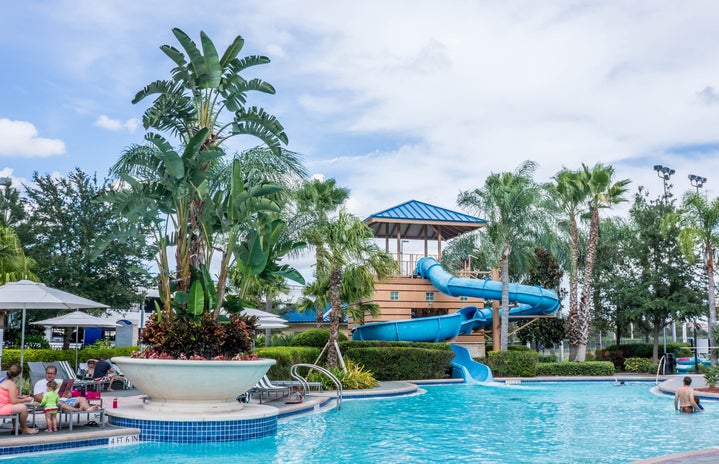Content Note: This article contains spoilers from the HBO series “The White Lotus”
If you haven’t already seen it trending on social media, The White Lotus is HBO’s latest hit TV show. This 6-part miniseries was produced, written and directed by Mike White, who is accredited for his ability to write about the shortcomings of human nature. The White Lotus is a comedy of errors that appears to be a midsummer murder mystery but unravels to become a commentary on white privilege, commodity culture, race politics and exploitation in tourism.
The series follows a group of privileged American tourists who go on a luxury Hawaiian holiday at The White Lotus resort. Following their interactions with each other and the staff at the resort, we are introduced to the star-studded cast. On the boat headed towards the resort, we see the white, privileged, Mossbacher family. Nicole Mossbacher (Connie Britton), CFO girl boss and her emasculated husband, Mark Mossbacher (Steve Zahn), are travelling with their two children: 16-year-old son, Quinn (Fred Hechinger), college student, Olivia (Sydney Sweeney) and her brown- skinned friend, Paula (Brittany O’Grady). On their honeymoon, newlywed couple Shane (Jake Lacy) and Rachel Patton (Alexandra Daddario) are aboard. Lastly, we meet Tanya (Jennifer Coolidge), who is introduced as a broken, wealthy, older woman who has come to the island to scatter her mother’s ashes. Awaiting their arrival on shore are Armond (Murray Bartlett), the narcissistic white resort manager; Belinda (Natasha Rothwell), the Black spa manager; and Lani (Jolene Purdy), a local trainee.
Everything from the cinematography to the mise en scène leaves the audience feeling anxious. The music alone sets the scene for the tragic events which are to transpire. With a dystopian, eerie feel, composer Cristobel Tapia de Veer creates an atmosphere of discomfort when looking at the most picturesque landscapes and polished interiors. White enlisted him to create a “tropical anxiety” through the score and he achieves this with every shrieking flute, moan and hypnotic drumbeat. We begin with a flash-forward to a scene at the airport, where a moody Shane watches a box labelled ‘human remains’ being transported onto the plane. This leaves the audience to question which tourist’s remains are being carried off throughout the series. From the opening credits, there is a suggestion that something sinister is about to happen in this tropical paradise. We are shown within the lustrous wallpaper, images of rotting fruit and dead fish, hidden amongst the tropical decoration. Not only does this allude to the toxic outcomes of high-end tourism but it also foreshadows the eventual undoing of each character.
White uses satire to comment on wealth, privilege and entitlement. Like the fruit and fish in the wallpaper, this group of wealthy guests are quite literally spoiled in their toxic privilege. What we learn from The White Lotus is that the wealthy elite would rather spoil in their misery than lose a fraction of the wealth which has caused them their unhappiness. As Mark Mossbacher put it during an uncomfortable debate on privilege with his daughter, “Nobody cedes their privilege.” He goes on to say, “It goes against human nature. We’re all just trying to win the game of life.” We are constantly being pulled between feeling sympathetic for the characters’ personal unhappiness and feeling disgusted at their toxic, entitled behaviour.
Throughout the entire series, Mike White has demonstrated how people of colour are used as props for its white characters to use as vessels of their desire and trauma. This can be seen through the relationship between Paula and Oliva, who uses Paula in order to “other” herself from the white privilege she inherited from her parents. Another example of this is the relationship between Tanya and Belinda. While Belinda devotes herself to healing Tanya, she is led to believe Tanya will fund her dream of opening her own wellness centre, however, this dream is short-lived as Tanya drops her as soon as she finds something else to obsess over.
Another theme present is the white saviour complex tourists submit to when visiting tropical destinations, like Hawaii. These tourists feed themselves the illusion that by travelling to these exotic, luxury getaways they are financially supporting the destinations. However, statistics have shown that the economic benefit of these transactions seldom benefit the local working class and almost 80% of their money spent ends up leaving the host country along with its tourists. Not only do these luxury all-inclusive resorts drain natural resources, but they divert customers from supporting local businesses.
What can be seen by Tanya’s initial attachment to Belinda, Olivia’s dependence on Paula and Quinn’s desire to leave behind his responsibilities and travel with the local outrigger canoeing team, is that they use the people of colour around them to spice up the mediocrity of their white culture. This highlights the class divide between the affluent white guests and the people of colour at The White Lotus. As the story unfolds, White makes clear where each character fits on the class ladder and how each one, whether intentional or not, makes the lives of those a step below them feel lesser. Repeatedly, we are shown how the top 1% use and discard those beneath them. Despite their attempts to get away, the people of colour surrounding them are sucked into their world, only to end up discarded and forgotten.
One might critique The White Lotus for showing these race, class and gender issues without making any constructive commentary on them. While the series mostly studies the relationships between its characters, it vividly depicts and dissects the intersecting systems of class and race. However, by the finale, just as some characters seem to have come to a turning point of self-reflection, there is a murder and everyone falls back into their original positions. This depressing ending was intentional and impactful. It is White’s way of saying that these systems of privilege and power cannot be stopped, only observed.
This grim tale of humanity comments on class, race and the toxic effects of luxury tourism under the guise of a simple murder mystery. While we are wrapped up in the day-to-day dramas of the wealthy elite, we get a glimpse of the unhappiness and dissatisfaction which they consider a worthy cost for their possessions, influence and experiences. It is a masterfully written, gripping tragicomedy with moments that every family member can connect with and it should definitely be added to your watch list this month.


